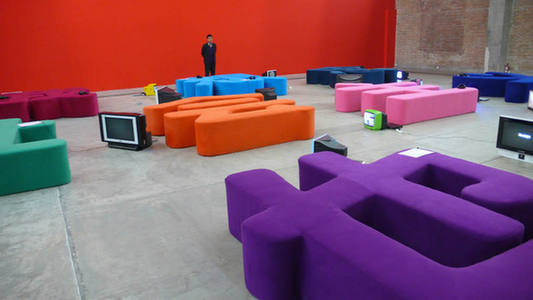| "798": A Romance of Art and Life
 |
| Installation art at 798. Wang Zhi |
NOT long ago, the American Newsweek magazine selected Beijing as one of the top 12 cities in the world, and the humanity and spirit reflected by 798 Art Zone with all the innovative potential it unleashes, played an important part in the choice. Newsweek mentioned 798 in the same breath as Manhattan's SoHo district. Now 798 is the most influential zone for fine art in Beijing, a place where domestic and foreign gallery-haunters, collectors, and artists are compelled to wander, ponder and purchase. On November 26, 2007, French President Nicolas Sarkozy visited 798 Zone, and expressed his appreciation. President of the European Commission Jose Barroso and former German Chancellor Gerhard Schroeder also made a point of visiting it. Xia Jifeng, chairman of the International Foundation of Culture and Art of Spain, remarked, "798 Art Zone has undertaken the important function of stimulating China's modern art industry."
In late 2010, video art entitled Stranger by new-media artist Fei Jun was exhibited in 798's Officina Art Studio. Fei Jun studied in Alfred University in the United States, and is now a professor of digital media at the Central Academy of Fine Arts. One of his works, a single-screen video Walking Blindfolded, tracks blindfolded Fei Jun walking in the Guomao and Jianguomen subway stations during the early morning rush hour, and around him are strangers racing to get to work on time. How its people interact with strangers is a distinguishing feature of any modern city, since most people one encounters in the run of a day are unknown to you and will never be seen again. Artist Fei Jun has been observing Beijingers carefully, and technically he's been exploring the impact on art and design of a mixed space formed by illusory and real spaces.
Zhu Qi, art critic and master planner of Beijing 798 Art Zone Biennale, said that the works on display in this zone use avant-garde and innovative expressive techniques, forms accessible to people born in the 1980s and 1990s. The themes are environmental protection, wildlife conservation, human health, and the negative effects of industrial society on us all.
798 Art Zone used to be a state-run electronic factory complex, Factory 798. Aided by the Soviet Union and designed by East Germany in the 1950s, even its contruction is an industrial project of interest to designers; some buildings are concrete-arch structures in typical Bauhaus style, very rare in Asia. Since 2002, over 400 art studios and modern art institutes from 16 countries and regions have settled here. The first artist to set up in 798 was Li Xiangqun, a professor with the sculpture department of the Academy of Arts and Design of Tsinghua University. Soon, 798 became the "low-lying land" where artists flowed and pooled. They rented and transformed the deserted factory spaces on an impressive scale. Gradually, 798 developed into a settlement concentrating art galleries, art centers, artist studios, design companies, fashion outlets, restaurants and bars. Within two years, it became the largest art zone in the country and the most influential beyond China's borders.
The SoHo-style art zone and Loft lifestyle of 798 have aroused interest both at home and abroad. Here, the one-time warehouses and factories have been redefined, designed and transformed, acquiring fresh architectural annotation and encouraging new lifestyles. The deserted, now transformed, plants have become architectural art works. A perfect dialogue has been maintained between historical context and new development, and between pragmatic utility and aesthetic value. The almost organic combination of modern art, architectural space, cultural elements, historical context and urban dwellings have made 798 a dynamic environment for modern life and culture. It has attracted both professionals and the general public, and created a new vista of the city as site of urban culture and life.
"Among the creators that inhabit 798 are world-renowned masters of arts and crafts as well as freshly graduated art school students," confided Sui Jianguo, a professor of the Central Academy of Fine Arts who was one of the earliest to rent a building in the zone. He said that the practical structures are tall and spacious, and the diffused quality of light entering the high and oddly placed windows are an artist's dream; such working spaces are highly sought after by serious artists.
|
